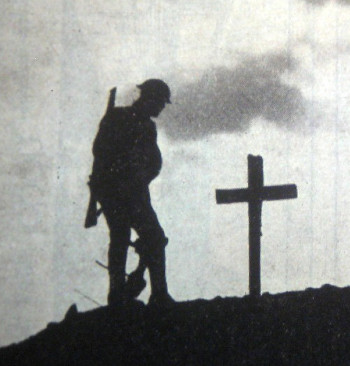St Werburgh's Roman Catholic Parish, Chester

John Rowlands
Pte 1st Btn King's Shropshire Light Infantry 7657
Died: 05-10-1914 age 27
The twins John and Selina Rowlands were two of the ten children born to John and Selina Rowlands nee McGiver of Chester, in July 1887. John was a Protestant shoemaker and a widower. Selina was a much younger Catholic girl, the daughter of Patrick Rowlands, also a Chester shoemaker. Their ten children were generally baptised first in an Anglican church and some time later, conditionally, in a Catholic Church, in Chester. Some of the children, like John and Selina, were baptised at St Francis’ and others were baptised at St Werburgh’s, depending on the address of the family at the time. During the 1880s the family lived in Watergate Street and in 1891 they lived in Royal Oak Yard.
Although ten children had been born, by 1901 four of them, Mary Elizabeth, Harriet, Elizabeth Ann and Patrick, had died in infancy. John Snr was also ill during these years and by 1911 the whole family had split up. William, the eldest child, had joined the Royal Navy. John, Thomas, Elizabeth and Joseph were living in the Chester workhouse and attending the school there, whilst Selina, John’s twin sister, was at the Catholic Children’s Home in Holywell. John Snr died in the workhouse in 1910.
In the 1911 census Selina was living at 15 Oswell Street, Rockferry, with all of her six children. William had returned from the Royal Navy and was working as a general labourer. John was working as a dock labourer and Thomas and Joseph were working as farm labourers. Selina was working as a housemaid and Elizabeth was still at school. Soon after this census the family probably moved back to Chester. (John’s mother Selina certainly lived in Duke Street until her death in 1940.) Sadly John’s twin sister Selina died in 1913 and was buried in Overleigh Cemetery. Also soon after this census, John must have enlisted with the King’s Shropshire Light Infantry at Frodsham, as his four digit number was issued before the start of the Great War.
John’s enlistment papers have not survived so we can know little of his army career. However, we know that as a regular soldier he would have been one of the first to go to France with the British Expeditionary Force. From the date and situation of his death we can deduce that he fell during the Battle of the Aisne. He may also have been involved in the preceding retreat from Mons and the Battle of the Marne.
Following the Allied victory at the Battle of the Marne in mid-September 1914, the German forces retreated to the high ground of the Chemin des Dames ridge on the north bank of the River Aisne. They dug trenches (supported by heavy artillery) and prepared to fight.
The Allied attack started on the morning of 14 September and although there were some initial gains, as the day wore on the battle descended into a series of attacks and counter-attacks, with both sides suffering heavy casualties. By nightfall on 14 September, British units on the north bank of the river had been ordered to dig trenches and reinforce their positions, which now spanned a twenty-mile front. Although the Battle of the Aisne continued for another ten days, neither side could claim a decisive victory. The German forces failed to drive the Allies back across the river, and the Allies were unable to push the Germans from the ridge. This ‘stabilization’ of the front marked the beginning of trench warfare - a gruelling stalemate that would last for almost four years.
It seems likely that John died during the action described above. He was buried in Grave I.B.12 of Vailly-sur-Aisne British Cemetery and was entitled to receive the 1914 Star, the British War Medal and the Allied Victory Medal.
